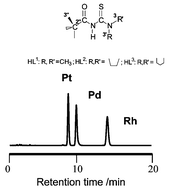Tailoring hydrophilic N,N-dialkyl-N′-acylthioureas suitable for Pt(ii), Pd(ii) and Rh(iii) chloride pre-concentration from acid aqueous solutions, and their complex separation by reversed-phase HPLC†
Abstract
A series of new, relatively hydrophilic, N,N-dialkyl-N′-(2,2-dimethylpropyl)thioureas (HLn) (n = 1, N,N-dimethyl-; n = 2, N-pyrrolidyl-; n = 3, N-piperidyl-) and their corresponding cis-[M(Ln-S,O)2] [for M = Pt(II), Pd(II); n = 1–3] and fac-[Rh(Ln-S,O)3] (n = 2, 3) complexes have been prepared and characterised. The crystal and molecular structures of fac-tris(N-pyrrolidyl-N′-(2,2-dimethylpropyl)thioureato)rhodium(III) and cis-bis(N-piperidyl-N′-(2,2-dimethylpropyl)thioureato)platinum(II) are reported, as representative examples. The favourable physiochemical properties and ready formation of stable mono-isomeric cis-[Pt(Ln-S,O)2] and cis-[Pd(Ln-S,O)2] complexes with these


 Please wait while we load your content...
Please wait while we load your content...